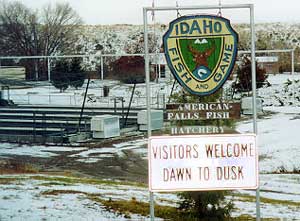 The
American Falls Hatchery is located in Power County immediately west of the town
of American Falls in southeast Idaho.
The
American Falls Hatchery is located in Power County immediately west of the town
of American Falls in southeast Idaho.
The American Falls Hatchery was originally constructed in 1932 and was rebuilt during the mid 1980's. This license funded hatchery stocked 102,418 catchable sized rainbow trout and 1,146,657 fingerlings for stocking in the southeast part of Idaho during 1998.
The hatchery is staffed by three permanent employees. An eight-month temporary employee is hired for the planting season. Funding for the hatchery operation comes from both license monies and from interest on an American Falls Irrigation District endowment.
Water for the hatchery comes from Reuger Springs located on the hatchery property. These springs flow an average of 20 cubic feet per second (cfs) at a constant water temperature of 55ºF.The Idaho Department of Fish and Game raises two genetic types of Rainbow Trout, 1) diploids and 2) triploids, at the American Falls Fish Hatchery to provide stock for the state's recreational fishing industry.
The hatchery is located just down river from Idaho Power's dam and hydropower facility near Reuger Springs above the Snake River.
The Hatchery was built circa 1934 in a cooperative effort by the State of Idaho and the Civilian Conservation Corps, a federal program; and is maintained by the State of Idaho Department of Fish and Game. Three full time employees live year round at the hatchery providing 24 hour on call services to prevent fatal catastrophes. Both state and private sources provide funding via fishing license revenues and donations. This module provides information about the history, physical layout, infrastructure, and the scientific methods behind rearing fish at the American Falls Hatchery.
The hatchery was built just below Reuger Springs; which provides warm and sterile water source year round for the hatchery. Water from the spring is a constant 55° Fahrenheit, and flows at approximately 20 cubic feet per second. Water is pumped throughout the hatchery.
The water is aerated before entering the raceways by gravity feed through degassing tower. It is considered sterile because unlike river water it is not exposed to the animal population, thus reducing input of fecal bacterial and other pathogens. A sterile environment is crucial because disease may decimate an entire batch of 500,000 to 1,000,000 fish during any phase in the rearing process.
The rearing process begins when fish eggs are delivered to the hatchery egg building. A typical batch may have 1,000,000 eggs but may be as small as 250,000. The fish eggs arrive packed in ice to keep them at or near freezing temperatures, much like a stream bed in winter. The eggs are transferred to an iodine bath (argentine solution: 38mg I/L H2O) kept at a constant 38° Fahrenheit, in order to sterilize the batch of eggs. This sterilization step insures that no disease can be transferred from the mother fish, or from contaminants derived during harvest, storage, or shipping. The iodine bath also prevents cross contamination of eggs from differing lineage.
An iodine footbath is also at each doorway to prevent the introduction of any contaminants that may be carried in on shoes.
When the batch is sterilized, the Fish and Game Biologists examine the eggs for defective or unfertilized eggs, then begin to process the batch into sub-populations for incubation.
The eggs are separated into sub-populations of 10,000 and put into trays to incubate until they mature to feeding fry. It is highly inefficient to count the eggs one at a time to get batches of 10,000 separated from 500,000, thus biologists have developed a scientific method to sort eggs based on the average mass of an egg. This methods has several steps which are:
When the eggs enter the Heathstacks they are in the soft eye stage, so called because the egg resembles an eye with a little black dot for a pupil. Initial mortality is high, averaging 1-2 percent. Mortality past the soft eye stage is much lower averaging 0.01 percent. The surviving eggs pass through the first three of four developmental stages while incubating:
The fish develop digestive tracts during these three stages; which take about five weeks complete. Upon maturing to feeding fry, the fry are transferred from the individual Heathstacks and combined into a vat. While in the vat, each batch is routinely measured to determine ideal feed quantities that maximize growth per input of food. The fish grow in the vats until they reach a uniform batch length of about 1-3 inches, representing maturation to the fingerling stage.
The fingerlings finish their growth cycle at the hatchery in raceways. The raceways are long cement river beds which have flowing water running their length to simulate life in a stream. The fingerlings are at their highest risk of mortality in the outdoor raceways because birds come to prey. Predatory birds do not only eat fish, but may introduce disease caught when eating fish from nearby streams. The Department of Fish and Game built nets and fences around the raceways to prevent such catastrophes. Ideally the fingerlings grow to a length of 10 inches. Fishery Biologists call this ideal size the target size. A batch of fish that reaches target size is ready for the wild. Staff members pump the fish out of the raceways using a tomato harvester. The biologists use the tomato harvester because it was designed to not bruise a tomato, therefore it should not bruise the fish. The fish pass through the harvester into a truck with a water tank mounted on it, a water truck. This truck hauls the fish to their next destination, an Idaho river, stream, or creek. Their final destination is the stomachs of anglers. However, a select few fish escape this fate by escaping the raceway into the stream that drains the raceways and feeds the Snake River.